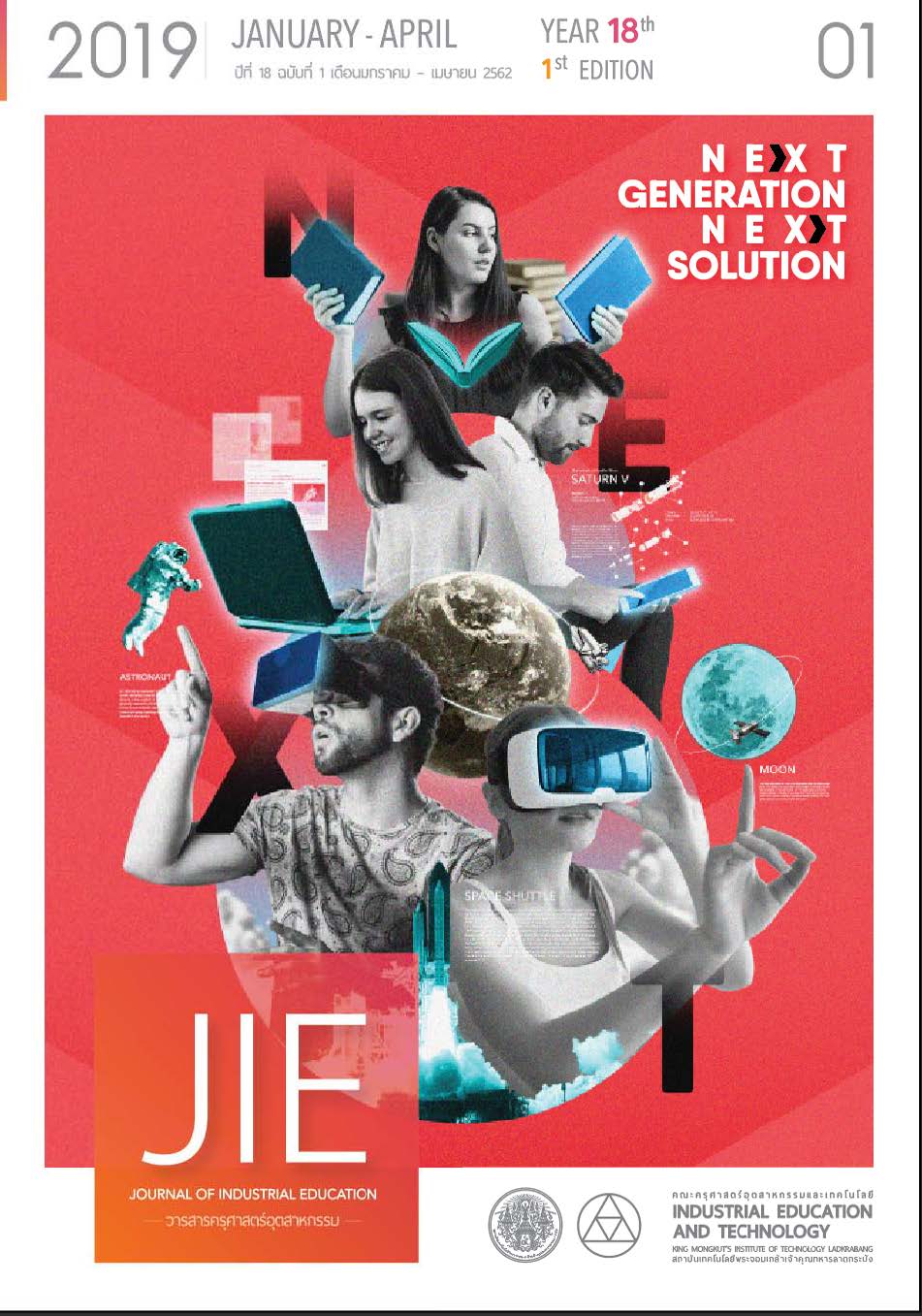การทบทวนวรรณกรรมอย่างเป็นระบบเกี่ยวกับรูปแบบกิจกรรมการสอนด้วยกระบวนการออกแบบวิศวกรรมที่มีผลต่อความสามารถในการแก้ปัญหาอย่างสร้างสรรค์ สำหรับนักเรียนมัธยมศึกษาตอนปลาย
คำสำคัญ:
กระบวนการออกแบบวิศวกรรม, การแก้ปัญหาอย่างสร้างสรรค์, กระบวนการทางวิทยาศาสตร์, การสร้างความรู้ด้วยตนเอง, การจัดการเรียนรู้แบบใช้ปัญหาเป็นฐานบทคัดย่อ
การศึกษานี้เป็นการทบทวนวรรณกรรมอย่างเป็นระบบ โดยมีวัตถุประสงค์ 1) เพื่อทบทวนวรรณกรรมอย่างเป็นระบบเกี่ยวกับกระบวนการออกแบบวิศวกรรมสำหรับการพัฒนาการแก้ปัญหาอย่างสร้างสรรค์ของนักเรียนมัธยมศึกษาตอนปลาย 2) เพื่อนำเสนอแนวทางการประยุกต์กระบวนการออกแบบวิศวกรรมร่วมกับรูปแบบวิธีการสอนอื่น ในการทบทวนวรรณกรรมอย่างเป็นระบบนี้กลุ่มตัวอย่าง คือ งานวิจัยต่างประเทศที่ศึกษาเกี่ยวกับรูปแบบกิจกรรมการสอนด้วยกระบวนการออกแบบวิศวกรรมที่มีผลต่อความสามารถในการแก้ปัญหาอย่างสร้างสรรค์สำหรับนักเรียนมัธยมศึกษาตอนปลาย โดยคัดเลือกงานวิจัยตีพิมพ์เป็นภาษาอังกฤษระยะเวลาย้อนหลัง 5 ปี คือ ตั้งแต่ปีพ.ศ. 2556 ถึงปีพ.ศ. 2561 (ค.ศ. 2013 ถึง ค.ศ. 2018) จำนวน 20 เรื่อง เครื่องมือที่ใช้เก็บรวบรวมข้อมูลเป็นแบบสังเคราะห์ที่สร้างขึ้นจากการทบทวนวรรณกรรม ผลการสังเคราะห์งานวิจัย พบว่ารูปแบบกิจกรรมการสอนด้วยกระบวนการออกแบบวิศวกรรมที่มีผลต่อความสามารถในการแก้ปัญหาอย่างสร้างสรรค์สำหรับนักเรียนมัธยมศึกษาตอนปลายมีดังนี้ 1) การกำหนดปัญหาหรือระบุปัญหา 2) การรวบรวมข้อมูล 3) การวางแผน 4) การออกแบบ 5) การปฏิบัติงาน 6) การทดสอบ 7) การปรับปรุง/การประเมินผลงาน และ 8) การนำเสนอ นอกจากนี้แนวทางการประยุกต์ร่วมกับรูปแบบวิธีการสอนอื่น มีดังนี้ 1) กระบวนการทางวิทยาศาสตร์ 2) การสร้างความรู้ด้วยตนเอง และ 3) การจัดการเรียนรู้แบบใช้ปัญหาเป็นฐาน ผลการวิจัยนี้สามารถนำผลงานวิจัยไปใช้เป็นแนวทางการจัดกิจกรรมการเรียนการสอนด้วยกระบวนการออกแบบวิศวกรรมที่มีผลต่อความสามารถในการแก้ปัญหาอย่างสร้างสรรค์ และเป็นแนวทางในการเตรียมความพร้อมหรือพัฒนาการจัดการเรียนการสอนแก่บุคลากร อาจารย์/ครู ด้วยกระบวนการออกแบบวิศวกรรม
เอกสารอ้างอิง
Ministry of Education. 2017. Core Curriculum Basic Education of Mathematics, Science and Geography Content in the Subjects of Social Studies, Religion and Culture (Updated edition 2017). Bangkok: Office Academic and Education Standards.
Chan, J. and C. Schunn. 2015. The impact of analogies on creative concept generation: Lessons from an in vivo study in engineering design. Cognitive Science, 39(1), p. 126-155.
Ragupathi, K.k.n.e.s. and H.h.h.u.c. Hubball. 2015. Scholarly Approaches to Learning Technology Integration in a Research-Intensive University Context: Impact of a New Faculty Initiative. Transformative Dialogues. Teaching & Learning Journal, 8(1), p. 1-16.
Bybee, R. 2010. Advancing STEM education: A 2020 vision. Technology and Engineering Teacher Journal, 70.
Thipakorn, B. and K.S. Tawornpichayachai. 2015. The Twenty-First Century Engineering Education: KMUTT Imagineering Program. Technology & Workplace Skills for the Twenty-First Century, p.71.
Saeedeh Ziaeefard, et al. 2017. Co-robotics hands-on ativities: A gateway to engineering design and STEM learning. Robotics and Autonomous Systems, 7(13).
El-Zein, A.H. and C. Hedemann. 2016. Beyond problem solving: Engineering and the public good in the 21st century. Journal of Cleaner Production, 137, p. 692-700.
Zhu, W., et al. 2018. Engineering Design and Manufacturing Education through Research Experience for High School Teachers. Procedia Manufacturing, 26, p. 1340-1348.
Esmaeilian, B., et al. 2018. Use of Citizen Science to Improve Student Experience in Engineering Design, Manufacturing and Sustainability Education. Procedia Manufacturing, 26, p. 1361-1368.
Moore, T., et al. 2014. Implementation and integration of engineering in K-12 STEM education, in Engineering in Pre-College Settings. Synthesizing Research, p. 48.
Mentzer, N., K. Becker, and M. Sutton. 2015. Engineering Design Thinking: High School Students' Performance and Knowledge, p. 417-432.
SÜRmelİ, H., et al. 2018. Secondary School Students' Performance and Opinions Towards Activities Based on Engineering Design Process, 47(2), p. 844-872.
Kuang-Chao, Y.U., L.I.N. Kuen-Yi, and F.A.N. Szu-Chun. 2013. How High School Students Apply Knowledge in Engineering Design Projects. International Journal of Engineering Education, 29(6), p. 1604.
Lammi, M.m.n.e. and K.k.b.u.e. Becker. 2013. Engineering Design Thinking. Journal of Technology Education, 24(2), p. 55-77.
Cross, J., et al. 2016. Engineering and Computational Thinking talent in middle school students: A framework for defining and recognizing student affinities. in 2016 IEEE Frontiers in Education Conference (FIE).
Kelley, T.R. and J.G. Knowles. 2016. A conceptual framework for integrated STEM education. International Journal of STEM Education, 3(1), p. 11.
Mentzer, N.j.e.n.p.e.. 2014. High School Student Information Access and Engineering Design Performance. Journal of Pre-College Engineering Education Research, 4(1), p. 31-42.
Cropley, D.H. 2016. Creativity in Engineering, in Multidisciplinary Contributions to the Science of Creative Thinking, G.E. Corazza and S. Agnoli, Editors. Springer Singapore: Singapore, p. 155-173.
Chien, Y.-H. and P.-Y. Chu. 2018. The Different Learning Outcomes of High School and College Students on a 3D-Printing STEAM Engineering Design Curriculum. International Journal of Science and Mathematics Education, 16(6), p. 1047-1064.
Denson, C.D.c.n.e. and M.m.n.e. Lammi. 2014. Building a Framework for Engineering Design Experiences in High School. Journal of Technology Education, 26(1), p. 75-87.
Wendell, K.B., C.G. Wright, and P.C. Paugh. 2015. Urban elementary school students' reflective decision-making during formal engineering learning experiences (Fundamental). Proceedings of the ASEE Annual Conference & Exposition, p. 1.
Lawanto, O., et al.. 2013. Pattern of Task Interpretation and Self-Regulated Learning Strategies of High School Students and College Freshmen during an Engineering Design Project. Journal of STEM Education: Innovations & Research, 14(4), p. 15-27.
Kanematsu, H. and D.M. Barry. 2016. STEM and Creativity, in STEM and ICT Education in Intelligent Environments, p. 15-23.
Starkey, E., C.A. Toh, and S.R. Miller. 2016. Abandoning creativity: The evolution of creative ideas in engineering design course projects. Design Studies, 47, p. 47-72.
Yoon Yoon, S.s.t.e., M.G.e.p.e. Evans, and J.j.t.e. Strobel. 2014. Validation of the Teaching Engineering Self-Efficacy Scale for K-12 Teachers: A Structural Equation Modeling Approach. Journal of Engineering Education, 103(3), p. 463-485.
ดาวน์โหลด
เผยแพร่แล้ว
รูปแบบการอ้างอิง
ฉบับ
ประเภทบทความ
สัญญาอนุญาต
"ข้อคิดเห็น เนื้อหา รวมทั้งการใช้ภาษาในบทความถือเป็นความรับผิดชอบของผู้เขียน"



